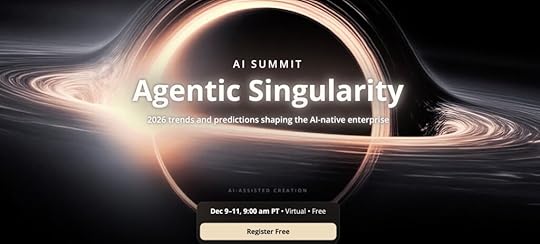Brian Solis's Blog
November 30, 2025
Brian Solis to Keynote REALM Global Collective 2026: Solstice
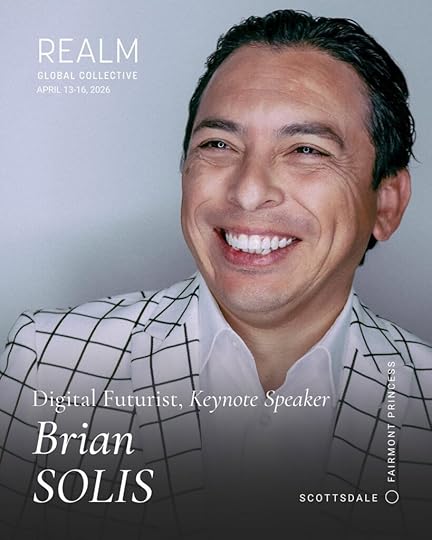
via Laura Monroe, REALM Global Collective
“Leadership is a decision you make about the future you are willing to fight for.” Brian Solis
I’m incredibly excited to share our first keynote speaker for REALM Global Collective | April 13–16, 2026 at The Fairmont Scottsdale Princess — someone whose work has shaped much of how we think about innovation, leadership, and human behavior: Brian Solis — world-renowned digital futurist, 9x bestselling author, and one of the most influential thinkers of our time.
Explore RGC 2026.
It’s hard to overstate Brian’s impact.
Forbes calls him “one of the more creative and brilliant business minds of our time.”
ZDNet describes him as “one of the 21st-century business world’s leading thinkers.”
Entrepreneur Magazine has recognized him as “a world’s top superforecaster.”
For more than two decades, Brian has been at the forefront of digital transformation—studying disruptive technologies, business model evolution, and the shifts in human behavior that often predict what comes next.
As the Head of Global Innovation at ServiceNow, he advises executives and leading global brands on the trends shaping our future and how to navigate them with clarity, adaptability, and purpose.
He is the author of nine bestselling books, including his newest, Mindshift: Transform Leadership, Drive Innovation, and Reshape the Future, a USA Today bestseller guiding leaders through the mindset shift required to thrive in an era of constant acceleration.
What I personally appreciate about Brian is his ability to humanize innovation. AI, automation, digital behavior, new consumer expectations—he translates complexity into insight, and insight into meaningful action.
His work appears regularly in Harvard Business Review, Fast Company, Forbes, CIO, Worth, and is followed by an online community of over 800,000, including leaders like Oprah, Shaq and more.
Brian brings exactly what RERALM members needs in this moment:
*A fresh lens for adapting to rapid change
*A human-centric approach to innovation
*A strategic guide for navigating consolidation, shifting consumer psychology, and AI acceleration
*A blueprint for how the advisor—not the brokerage—becomes the ultimate differentiator.
As we come together under our 2026 theme, Solstice, and step into a year centered on illumination, vitality, and transformation, Brian’s perspective will help us understand the light ahead—and how to lead others toward it.
It’s a mindshift that will help the world’s most trusted real estate advisors and luxury brokers future-proof their businesses and elevate their leadership in entirely new ways.
I cannot wait to welcome Brian Solis to the REALM Global Collective stage.
REALM Global Collective is more than an event- its an experience shaping what’s next in global luxury. Once a year, for REALM members, partners and guests. Join us.
The post Brian Solis to Keynote REALM Global Collective 2026: Solstice appeared first on Brian Solis.
November 24, 2025
Rethinking Leadership and Innovation in an AI-First World
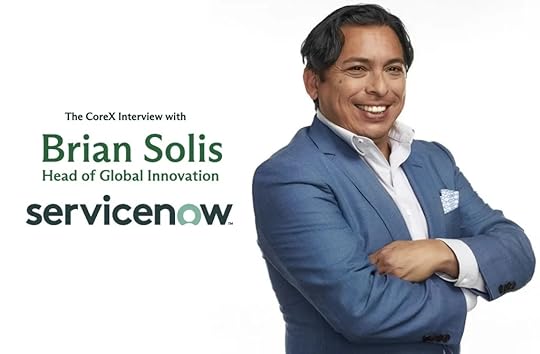
Brian Solis recently spent time with David Kirkpatrick, CoreX, exploring the new world with AI and how leaders, at every level, can rethink their way forward.
Artificial intelligence represents a new era of thinking. Few people capture this shift as sharply as Brian Solis, Head of Global Innovation at ServiceNow, bestselling author, and renowned digital anthropologist.
With his latest book, Mindshift: Transform Leadership, Drive Innovation, and Reshape the Future, Solis challenges leaders to move beyond fear and efficiency toward curiosity, creativity, and reinvention.
We were thrilled to get a few minutes of Brian’s time. In this candid conversation with our lead writer, David Kirkpatrick, he explores what it truly means to lead (and live) in an increasingly AI-driven world.
What does it mean to operate in a post-industrial, AI-first world?Brian Solis: In the industrial and even the digital era, value accrued to companies that could standardize, scale, and optimize. For more than a century, businesses were built on industrial-age principles: efficiency, scale, and standardization. We’ll add cost-takeout for good measure.
Even as we entered the digital era, most companies simply digitized those old processes rather than truly transforming them. The result? Faster, shinier versions of yesterday’s systems.
But AI changes the game entirely. It’s not just a new technology layer; it’s a new operating system for business and society. At least it should be. But the threat to progress is holding on to the past. For example, we see many companies automating yesterday’s processes that were recently digitized.
In a post-industrial, AI-first world, intelligence becomes abundant and accessible. The companies that will thrive are those that stop thinking in terms of “how we’ve always done things” and instead design for continuous adaptation and infinite scalability.
AI allows us to move beyond the limits of yesterday’s work and traditional hierarchies. And for those who are curious to explore new horizons, it creates the potential for digital employees, AI agents, and new forms of collaboration between humans and machines.
It’s important to note that this AI revolution isn’t about replacing people; it’s about elevating human potential and augmenting capacity so that creativity, problem-solving, critical thinking, and innovation become the focus, while AI handles the repetitive and routine to free up resources for augmented work.
What’s the difference?Brian Solis: Automating work is doing what we did yesterday, better, faster, less expensively, at scale. Augmenting work is doing what we couldn’t do yesterday or couldn’t imagine yesterday without AI.
Operating in this new world demands courage. It means letting go of legacy thinking and becoming comfortable leading when the map is still being drawn. Leaders must become architects of a future that doesn’t yet exist. And that’s both exhilarating and deeply challenging, but it is the way forward.
Where is the market moving near-term? What are leaders worried or excited about?Brian Solis: Right now, I’m seeing a clear divide between two mindsets. Some leaders are gripped by uncertainty and therefore lean on what they know. They see AI and disruption as a threat to jobs, to their business model, even to their own roles as leaders. Others are leaning in, recognizing that periods of great disruption are also periods of unprecedented opportunity.
The near-term marketplace is moving toward agentic automation: AI that doesn’t just assist but actively works alongside people, autonomously, but with a human orchestrator. Think of it as going from apps to intelligent interns who extend human capacity to increase output, and then using the time and resources saved to unlock entirely new possibilities.
This is where the most forward-thinking companies are investing: in systems that can orchestrate work, learn continuously, and drive outcomes without constant human supervision. But then they ask a critical question: What can we do with the time and resources saved that we couldn’t do before?
There are two sides to always consider…
Excitement comes from what this unlocks: New revenue models, entirely new markets, and the ability to deliver new value for employees and customers at scale.
Anxiety comes from the unknown: Can legacy companies move fast enough? Can they upskill their workforce in time? Will AI replace jobs? Can they identify use cases that push the boundaries of AI’s status quo and also deliver ROI? Can they build trust and governance to deploy AI responsibly at speed and scale?
The truth is, the next 18–24 months will determine which companies leap ahead and which become irrelevant. Leaders aren’t just navigating disruption; they’re navigating a complete rewriting of the business playbook.
What should people take away from Mindshift about meeting disruption head-on?Brian Solis: Mindshift is deeply personal for me because we are experiencing some pretty disruptive times, beyond AI.
Technology will continue to evolve at breakneck speed. Markets will shift. Competitors, new and old, will rise. And even though most of these disruptions arrive without a playbook, the good news is that the one thing leaders can always control is their mindset. And it is mindset that drives meaningful change in the absence of use cases and playbooks.
But how you see the world, how you interpret change, and how you respond, that’s entirely within your control. That’s why this book means so much to me.
The book is an invitation to replace fear with curiosity, to replace finite outcomes with infinite possibilities, and to encourage leaders, no matter where they sit in the organization, to step forward and help us break new ground, to inspire a new way forward, and to bring others with them.
In Mindshift, I share practical steps for cultivating this open, creative, and curious mindset:
Be open to challenging assumptions. Just because something worked yesterday doesn’t mean it will tomorrow. And that’s okay!Create psychological safety. Teams must feel safe to experiment, fail, and learn; otherwise, innovation dies.Lead with vision, not just metrics. Though companies rally around quarterly targets, growth is rooted in purpose. People want to see a better future, believe they play a role in it, and rally around that shared vision and dream.At its core, the book is about awakening the leader within each of us. Real possibility and innovation begin with how we think and how we choose to act.
Is technology transformation just the enablement layer? And are we ready for what it entails?Brian Solis: Technology is the spark, but transformation is human. And the future is augmented, a balance between human and machine potential.
Every major innovation in history, from electricity to the internet to smartphones, has only delivered value when people and organizations changed their behaviors, structures, and cultures to match its potential.
Right now, most companies are in the early stages of this journey with AI. They’re experimenting, piloting, even celebrating small wins. Some are also raising their hands in frustration, unable to document meaningful ROI. But the deeper question is: Are we ready to reimagine work itself?
We have to rethink everything, from how we measure success to how we design jobs, teams, and even leadership roles. The future of work isn’t just about humans doing tasks faster; it’s about humans and AI creating entirely new categories of value together. That requires reskilling at scale, a new social contract between employers and employees, and a commitment to ethics and trust at every level.
So yes, technology is the enabler. But readiness isn’t measured by how many AI tools you’ve purchased; it’s measured by how willing you are to let go of the past and design for the future.
What else should the CoreX audience know?Brian Solis: The companies that will define the next decade won’t be the ones with the most AI pilots or the safest use cases. They’ll be the ones who choose reinvention over optimization.
Too many organizations are using AI to make yesterday’s processes a little faster or a little cheaper. That’s not transformation, it’s iteration. And that’s ok, but it needs to be balanced with augmentation and innovation, otherwise it’s just a modern version of survival mode.
Ask yourself: Are we using AI to improve the past or invent the future?
The real opportunity is to create entirely new flywheels of growth, where every interaction generates data, every insight fuels smarter action, and the system continuously improves itself.
We’re at a point in history where each of us, as leaders, innovators, colleagues, and humans, has a choice. We can be passive participants in someone else’s future, or we can be active architects of our own while empowering those around us. AI gives us the tools to imagine what’s possible. Mindshift gives us the mindset to make it real, beyond what we thought was possible.
That’s why we need a new genre of leader. We need people who are willing to learn, unlearn, and surround themselves with people and technology that push the boundaries of what is possible, not what was possible or expected.
Closing ThoughtsAs Solis reminds us, AI’s greatest disruption is philosophical. The winners of this new era will be those who have the courage to rethink what work means, who it serves, and how it evolves.
Because, in the end, transformation isn’t just about implementing a tool or following a roadmap. It’s about leading with vision when the map has yet to be created. Because in a world defined by intelligence, the real differentiator is mindset.
—
Brian obviously has a lot to share. Don’t miss the chance to follow him on LinkedIn, X (formerly Twitter), Facebook, and Instagram. Also, be sure to check out his website, which contains a treasure trove of insights on business innovation.
—
Read Mindshift | Subscribe to a Quantum of Solis | Book Brian as a Speaker
The post Rethinking Leadership and Innovation in an AI-First World appeared first on Brian Solis.
November 23, 2025
Here’s What Makes Change Agents and Leaders Successful
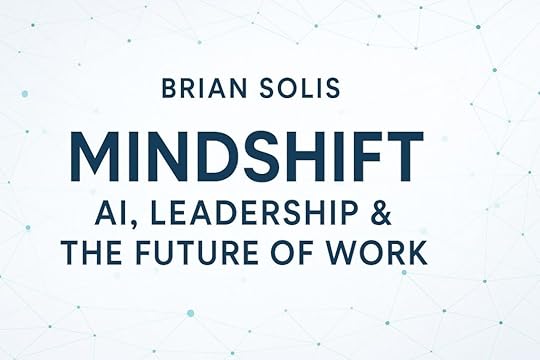
I meant to share this from InnoLead….I hope it adds value to your day.
In my work with change agents over the years, one thing has become clear: leadership is a decision you make about the future you are willing to fight for.
When I wrote “The Digital Change Agent’s Manifesto” back in 2019, I interviewed leaders driving transformation at brands like The Coca-Cola Company, Starbucks, Samsung Electronics, Visa, and others. They were not always in big roles. Many were “reluctant leaders” who did not love politics or bureaucracy, but they saw where technology, customer behavior, and employee expectations were heading, and they simply could not sit still anymore.
“Although it may seem counter-intuitive, to manage detractors, change agents ought to listen closely to their feedback. It is better to let them voice their concerns than to let them detract in secret. By listening to their concerns and the rationale for why they resist specific efforts to transform the organization digitally — and by trying to understand their motivations — change agents can turn detractors into allies. Most vocal critics can become your biggest advocates if you spend time with them.” – The Digital Change Agent’s Manifesto
In Mindshift, I tell the story of why people like this are critical to competitiveness. These individuals exist in your company, and they’re the real catalysts of progress. They translate trends into action. Find them. Empower them. Maybe it’s you…?
These leaders will only stay in a company as long as they feel they can affect change from where they sit. They step out of their comfort zones, learn to manage up and across, and over time they earn influence, build alliances, and often grow into formal leadership roles.
There is no single personality profile for a change agent. Introverts and extroverts, cautious planners and chaos-friendly starters, all showed up in the research. What they shared was conviction, curiosity, and a willingness to do the hard emotional work of navigating corporate systems to move the organization forward.
Simon Sinek is right: leadership is not a rank, it is a choice. Steve Jobs added an important dimension. The best leaders are not just thinkers or doers, they are both. They are self-managing, aligned around a clear vision, and fueled by passion that keeps them going when any rational person would give up.
If there is a takeaway for all of us, it is this:
– You do not need permission to become a change agent.
– You do need a clear vision of a better future and the courage to act on it.
– You will need to learn the politics of influence, not to play games, but to unlock progress.
The future belongs to those inside organizations who are willing to say, “I am no longer accepting the things I cannot change, I am changing the things I cannot accept,” and then back it up with action, empathy, and perseverance.
Are you waiting for a leader, or quietly becoming one?

Source: Innolead
This piece is excerpted from the new book Mindshift: Transform Leadership, Drive Innovation, and Shape the Future.
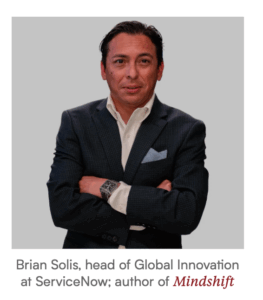
Before we continue, when I use the term change agent, I simply mean a believer in and catalyst of progress; this is someone who sees a better future and is on the cusp or in the process of becoming a leader. I am not referring to leaders of marketing or publicity initiatives masquerading as meaningful change.
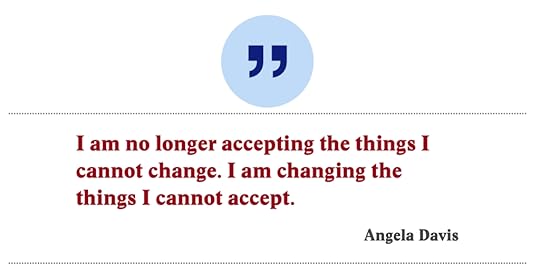
The change agents I studied were often not officially sanctioned to lead change. They generally were not 100% confident that it was their place to speak up and champion what they were advocating. They were often reluctant to step up to leadership. Nor did they desire to campaign for a change-management role or believe in traditional change management. Many were not fans of corporate procedure, and certainly not of bureaucracy. They called to mind something Jony Ive once said: “I always thought that the idea of a company was a necessary evil to make an idea relevant.” He laughed, but he was serious.
These change agents ended up moving their organizations forward nonetheless, because they also shared the belief that they had an understanding of the potential impacts of disruptive technologies and they were willing to play a role in helping their teams and organizations capitalize on them. That fueled their transition from their comfort zones to conference rooms and eventually boardrooms.
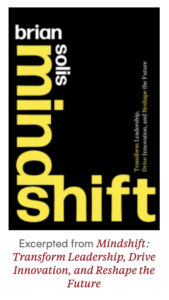
They collectively described themselves as problem-solvers and critical thinkers. But they also differed in some traits. Some said they are extroverts and others introverts. Some said they find comfort in chaos and being self-starters. Others said they are cautious and need internal support and validation to further their efforts. In other words, there is no one type of person who can become a change agent.
My research found that change agents can rise from anywhere in the organization. No matter where they sit, they all care passionately about translating trends into actions. When I asked these leaders whether they were committed to staying at their current employers or might consider moving to the proverbial greener grass of a new company, they responded time and time again that they would stay as long as they believed they “could effect change here.”
Change agents step up to lead mindshifts because they care so much about their companies succeeding. They pay close attention to trends reshaping their markets, whether that’s evolving customer expectations or behaviors, changing employee expectations and desires, or emergent technologies. They seek to understand what’s happening and why, and they explore ways to proactively respond.
At some point, a mindshift takes place in their career and they realize that they can’t just sit idly waiting for someone else to rise and lead the way. It’s their willingness and willful thinking that helps them evolve to become leaders, in phases, not overnight. They are not always skilled at first in getting buy-in, and most are turned off by the politics of organizations. They also probably wouldn’t refer to themselves as change agents.
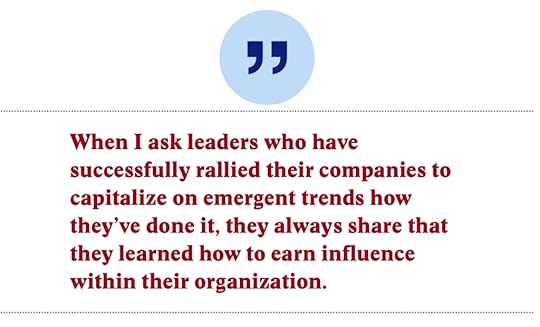
Despite their aversion to corporate politicking, because these leaders realize that their expertise can be productive and beneficial to the rest of the organization, they put the work in to learn to navigate corporate relationships better and become skilled in the art of “managing up” and “managing across,” with colleagues in different areas of the organization, to rally support and collaborate on the change process.
When I ask leaders who have successfully rallied their companies to capitalize on emergent trends how they’ve done it, they always share that they learned how to earn influence within their organization. They formed strategic alliances, focusing not just on managing their teams well, but on building relationships with key decision-makers, eventually including those at the executive level, even including those in the C-suite.
Over time as they influence positive change, they often rise into official leadership positions. Their ability to understand trends, their vision, and their ability to bring people together make them “heroes” in their organization, though they definitely wouldn’t describe themselves that way.
Leadership Is Not a Rank, It’s a ChoiceThis heading is a quote from Simon Sinek, author of a bestselling book on leadership, Leaders Eat Last. In his research on leadership, he found that so many people in business who are in leadership positions are not truly leaders. “I know many people at the senior most levels of organizations who are absolutely not leaders, they are authorities.” He points out, “We do what they say because they have authority over us, but we would not follow them. I know many people who are at the bottoms of organizations who have no authority, and they are absolutely leaders.”
What makes for a true leader? I can find no better authority on this than Steve Jobs.
When asked about what he looked for in the people he wanted to bring into the company to help him lead the Apple revolution, he said,
“The greatest people are self-managing—they don’t need to be managed. Once they know what to do, they’ll go figure out how to do it. What they need is a common vision. And that’s what leadership is: having a vision; being able to articulate that so the people around you can understand it; and getting a consensus on a common vision.”
Jobs sought people who believed in better outcomes, not the traditional managed outcomes. In a later interview, he recounted:
“We wanted people who were insanely great at what they did, but were not necessarily those seasoned professionals. We went through that stage at Apple, where we went out and we thought, ‘We’re going to be a big company, let’s hire professional management.’ It didn’t work at all. Most of them were bozos. They knew how to manage, but they didn’t know how to do anything!”
“You know who the best managers are?” Jobs asked. “They’re the great individual contributors who never ever want to be a manager but decide they have to be a manager, because no one else is going to be able to do as good a job as them.” He emphasized that they are doers in addition to visionaries. He didn’t believe a person is necessarily one or the other. When he was asked in one interview about the balance between thinking and doing in innovating, he responded, “My observation is that the doers are the major thinkers. The people that really create the things that change this industry are both the thinker and doer in one person.”
Steve Jobs also stressed passion, and he saw it not as anything romantic, as only a strong feeling; he saw it as a form of pragmatism. At a 2007 conference, Jobs was joined by Bill Gates for a conversation on innovation and future trends. Each was asked to share his single, most valuable piece of advice. Jobs responded:
“People say you have a lot of passion for what you’re doing, and it’s totally true. And the reason is because it’s so hard, that if you don’t, any rational person would give up. You have to do it over a sustained period of time. So, if you don’t love it, if you’re not having fun doing it… you’re going to give up. And that’s what happens to most people, actually. If you really look at the ones that ended up being successful in the eyes of society, and the ones who didn’t, oftentimes it’s the ones that are successful, love what they did so they could persevere when it got really tough. And the ones that didn’t love it, quit. So, you gotta love it, you gotta have passion.”
Jobs then called this advice the high-order bit, borrowing a programming term that describes the bit position in a binary number with the greatest value. In other words, passion trumps all. As he said, “People with passion can change the world for the better.”
In his must-see Stanford commencement speech in 2005, Jobs commended the graduates, “You’ve got to find what you love. The only way to do great work is to love what you do. If you haven’t found it yet, keep looking. Don’t settle. As with all matters of the heart, you’ll know when you find it.”
Please read and share! What’s your experience in driving change, especially in an era of AI?
—
Read Mindshift | Subscribe to a Quantum of Solis | Book Brian as a Speaker
The post Here’s What Makes Change Agents and Leaders Successful appeared first on Brian Solis.
November 21, 2025
From Siloed Experiments to AI Operating System: Architecting the Next-Gen Enterprise Right Now
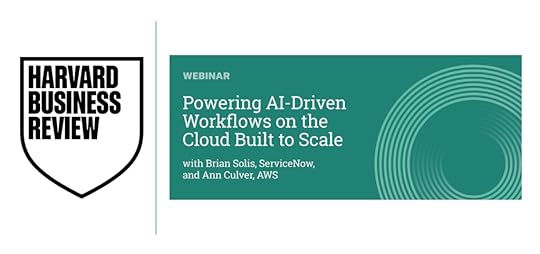
I recently had the opportunity (again!) to work with Ann Culver from Amazon Web Services (AWS) and Todd Pruzan at Harvard Business Review  on a special webinar and playbook. And they’re now available! (email gate). Links below!
on a special webinar and playbook. And they’re now available! (email gate). Links below! 
Why this is worth your time…
We dug into a tension we’re seeing in C-Suitesand boardrooms: Most organizations are still stuck in AI “pilot purgatory” and the box of “business as usual.” Companies have PoCs, scattered experiments, and a lot of hype, but not a scalable, enterprise-wide AI operating model.
Ann and I explored the shift from tools to transformation. AI-driven workflows are not about sprinkling models on top of yesterday’s processes. They are about orchestrating work differently end to end, powered by connected, trusted data, robust governance, and a culture that’s ready to operate at the speed of, well, not business as usual.
We also explored the shift from simple assistants to agentic AI: systems that can reason, collaborate, and make autonomous decisions across workflows.
Gartner projects that within 3 years, 15% of day-to-day work decisions will be made autonomously. This represents a new management reality, where leaders must design for humans and agents to work together across cloud, data, and workflow/cloud platforms.
 SPOILER ALERT: Companies are already repeating the worst mistakes of the digital transformation era. They are funding siloed AI initiatives, over-indexing on short-term potential, and under-investing in vision, culture, and scale. That’s why a recent ServiceNow study shows organizations’ AI maturity scores actually declined in the last year, dropping from 44 out of 100 to 35. Then there’s that viral MIT study…
SPOILER ALERT: Companies are already repeating the worst mistakes of the digital transformation era. They are funding siloed AI initiatives, over-indexing on short-term potential, and under-investing in vision, culture, and scale. That’s why a recent ServiceNow study shows organizations’ AI maturity scores actually declined in the last year, dropping from 44 out of 100 to 35. Then there’s that viral MIT study…
The message we wanted to land is this…
You don’t fix this with another pilot; you fix it by reimagining how your business works with AI at the center. Data + Workflows + AI.
When you unify distributed data, connect systems across end-to-end workflows (rewiring the enterprise), and run on cloud built to scale, you can lower costs by orders of magnitude, achieve 3x faster operational speeds, and save millions by optimizing processes with AI…all while improving customer response times, NPS, and lifetime value.
From there, then imagine the enterprise value you can unlock when you dream bigger! 

AI at scale starts at the top, not in the lab. Moving from pilots to production requires top-down leadership, a cohesive AI strategy, and a clear business case that links AI directly to revenue growth, cost reduction, and better risk outcomes. Experiments without executive ownership and an enterprise roadmap rarely scale.
We are entering the age of agentic AI, not just clever copilots. The evolution from basic AI assistants to multi-agent, reasoning systems means more and more daily decisions will be made autonomously. Leaders need to design workflows, governance, and operating models for humans and AI agents working together, not in parallel universes.
Silos are the silent killer of AI ROI. Many organizations are still making fragmented, department-level AI bets, as they did with early digital initiatives. Because AI needs connected data, people, and processes, siloed investments make it nearly impossible to show meaningful ROI or build an “AI-powered business,” not just pockets of automation.
Governance and innovation have to walk hand in hand. Over-rotating to compliance slows everything down; ignoring governance creates risk and backlash. The organizations that win are building centers of excellence, boards, or federated models that keep governance “front and center” while still leaving room to experiment, learn, and even fail quickly on the way to scale.
Start small, but design for big. High-impact, low-complexity use cases are the best entry point, but they should be chosen as part of a broader roadmap, not as isolated experiments. Each successful workflow becomes a proof point, a pattern, and a piece of the broader AI operating system you are building across the enterprise.
Empower people, don’t just upskill them. Training matters, but what really unlocks transformation is helping employees see how AI can change the nature of their work – shifting from repetitive tasks to higher-value creativity, curiosity, and problem solving. That means transparent communication, visible early wins, and AI champions in every business function to normalize AI as part of everyday work.
Cloud plus workflow is where scale actually happens. Together, ServiceNow and AWS provide an integrated platform for AI workflows: unifying data, hiding operational complexity, and enabling industry-specific agents that deliver intuitive, personalized experiences. With our “customer zero” approach, we test AI internally first so customers can move faster and with more confidence in their own environments
If you’re serious about moving beyond pilots and building an AI-driven enterprise that can truly scale, I encourage you to watch the full webinar, “Powering AI-Driven Workflows on the Cloud Built to Scale,” on HBR and download the accompanying webinar summary playbook to dive deeper into the frameworks, examples, and next steps we discussed.
Read Mindshift | Book Brian as a Speaker | Subscribe to a Quantum of Solis
The post From Siloed Experiments to AI Operating System: Architecting the Next-Gen Enterprise Right Now appeared first on Brian Solis.
November 20, 2025
What Would AI Do? A Simple Mindshift to Unlock Exponential Creativity (WWAID)

This week at ServiceNow, we hosted an internal AI Innovation event that left me incredibly energized about what’s next.
We kicked off with a powerful keynote from Jeremy Utley, author of Ideaflowand director of executive education at Stanford d.school. He shared how AI can amplify human creativity and unlock new ways of thinking.
We then spotlighted Amit Zavery, our President, CPO, and COO, who’s been leading our journey to becoming truly AI-native!
We also featured insights from Paul Hong, ServiceNow VP of Design and Swati Raju, VP of Engineering.
During a our conversation, Paul asked me:
“Brian, from your perspective, how does adopting an AI-native mindset expand what’s possible — for individuals, teams, or even entire product areas? Can you share an example where integrating AI sparked a new idea, accelerated a project, or revealed a possibility that didn’t exist before?”
Here’s how I’m thinking about it 
The mindset shift for me is stepping back and exploring what I didn’t know to know.
An AI-native mindset implies AI isn’t an add-on. It’s the core. If AI weren’t part of the equation, the solution wouldn’t (or couldn’t) exist.
That requires the acceptance of an uncomfortable truth: I am in the way.
My thinking, my approach, my assumptions and biases are inherently not AI-native.
The output on the other side of AI is just a reflection of the thinking and design that went into it. So to truly embrace an AI-native mindset, I have to stop starting with, “What would I do?” and instead ask:
WWAID…“What would AI do?”
When I start there, I’m forced to rethink my prompts, my constraints, and my expectations.
I shift from drawing on “known knowns” to intentionally designing for possibility.
That’s where innovation lives…in the creation of new value.
QuantumBlack, AI by McKinsey research shows that reimagining end-to-end workflows with AI is the #1 driver of EBIT impact. Not bolting-on AI, but rethinking the whole system.
Please watch the video for the rest of the story…
That’s the power of an AI-native mindset: treating AI not as a tool to speed up what we already do, but as a partner to help us discover what we couldn’t see before.
Please watch (and share) – Youtube! 
Read Mindshift | Book Brian as a Speaker | Subscribe to a Quantum of Solis
The post What Would AI Do? A Simple Mindshift to Unlock Exponential Creativity (WWAID) appeared first on Brian Solis.
November 15, 2025
Weaving a Web of Agents: ChatGPT Atlas Turns Search into Action and Discovery into Outcomes
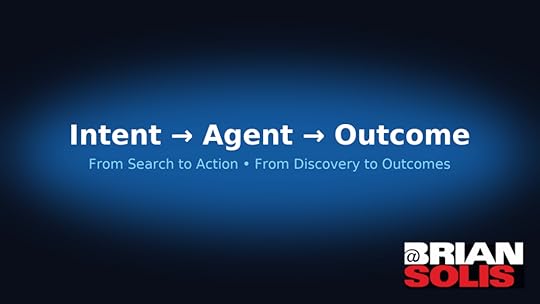
I haven’t written about a browser since the early 2000s.
We are about to change how we discover, decide, and do things on the web again. And the very purpose of the web is shifting. For decades, the web was built for humans clicking links. The next era is being built for agents completing tasks. I’ll unpack that bigger shift in a follow-up, but first, let’s look at what’s here now and why it matters.
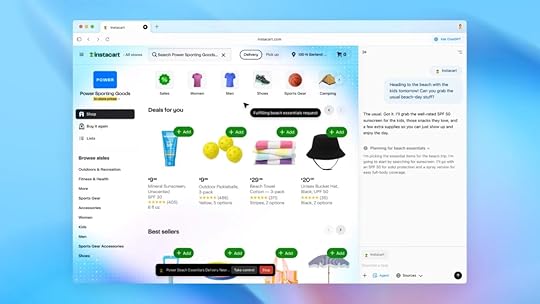
OpenAI’s ChatGPT Atlas and Perplexity’s Comet are not “browsers” in the classic sense. They introduce a new interaction model that collapses research and execution into a single flow.
Atlas puts ChatGPT inside the browser. You don’t type keywords and open tabs. You state the outcome you want and Atlas searches live, reasons across pages, and then acts. Research, shopping, travel, form fills, reservations. The result is less tab juggling and more finished work.Comet turns every page into an interactive surface. You can highlight anything, ask for counterpoints, follow tangents, and then act without losing context. It turns curiosity into momentum.
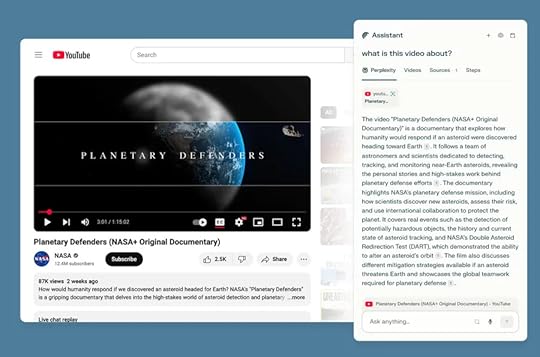
Both serve as personal assistants and agents.
The plot thickened when Microsoft shipped a nearly identical AI experience in Edge days after Atlas. That signals where platforms are going: agentic browsing becomes intentional.
This is the challenge and the opportunity. We’re moving from a web of browsing and transactions to a web of discovery, action, and outcomes.
The Shift from Keywords, Links, and Pages to Discovery, Decisions, and ActionsFor 20+ years the browser was a window. You typed a query, opened a dozen tabs, skimmed, copied, pasted, filled forms, and stitched the journey together yourself. The final mile was do-it-yourself.
In the agentic model, the browser becomes co-pilot and flight controller. You express intent, it gathers sources, weighs options, and executes. It returns a plan, a basket, a booking, or a brief. Fewer tabs. Faster decisions. More outcomes.
Atlas bakes ChatGPT into the browsing loop.Comet fuses Perplexity search with in-page reasoning.Edge’s new AI mode makes “do the task” a default pattern.This introduces a web that works for you.
Field notes: stress-testing Atlas in New YorkAhead of a trip to New York, I asked Atlas for the hottest restaurants, logged in where it suggested, set windows for lunch and dinner plus party size, and watched it research and attempt to book. When it couldn’t, it added me to waitlists and notifications. End-to-end tasking without a spreadsheet of tabs. I’ll post where I landed on IG.
Watch video here .
I’ve found reasons to use both Atlas and Comet, and I’m still learning the nuances. What’s clear: behavior shifts to intention to action to outcomes. People will expect planning, comparison, and checkout in one flow. Hands on the wheel, but less time on the road.
So what actually changes?1) Discovery compresses. We move from “find pages” to “produce outcomes.” Tasks, not queries, become the unit of value.
2) Trust becomes a ranking signal. Agents will privilege content with provenance, recency, and clear policies over thin pages and click-bait.
3) Design tilts toward machine readability. If your information can’t be parsed, reasoned over, and acted on by an agent, it risks being sidelined.
SEO isn’t Dead, but the SEO Playbook is…Classic SEO was written for crawlers and clicks. The next play is AEO: AI Experience Optimization. Design your content and commerce so agents can understand, trust, and transact. That’s where the web is going. Less a web for human consumption alone and more a web designed for LLMs and agentic processing.
What to do now
Make data callable. Expose inventory, pricing, availability, and policies through secure, well-documented APIs.Make knowledge machine-readable. Use structured schema, product graphs, sources, timestamps, authorship, and update cadence.Create action surfaces. Provide booking endpoints, carts, quotes, claims, and warranty flows so agents complete tasks, not just summarize pages.Publish agent briefs. Maintain concise, up-to-date fact sheets and constraints that LLMs can ingest and execute against.How companies win from hereShip APIs first. If an agent can’t call it, customers won’t complete it.Structure everything. Treat metadata like a product.Prove trust. Transparent sourcing, policies, and recency become the new PageRank.Measure outcomes, not visits. Track assistance rate, time-to-decision, completion, and repeat runs.Pilot an agentic journey. Pick one flow, whether it’s returns, warranty, claims, B2B quoting, and rebuild it for “state intent, decide, do, outcome.”What This Means for Business LeadersAgentic browsing is not a feature race, well…it’s a race toward shifting how you, and namely agents use the web. Essentially, it’s a shift in how value is created and captured online. When tasks and outcomes, not search and clicks, define success, the winners will be discovered and become part of the solution or outcome..
We’re moving from pages to progress. From browsing to doing. From ad-driven clicks to agent-driven completions.
It’s time to build for the agentic age and to learn when and how to let agents navigate and execute on your behalf.
Maybe now, we can finally close those tabs. We’ll see…I counted 30 open tabs as I finished this newsletter. 
Read Mindshift | Book Brian as a Speaker | Subscribe to a Quantum of Solis
The post Weaving a Web of Agents: ChatGPT Atlas Turns Search into Action and Discovery into Outcomes appeared first on Brian Solis.
November 14, 2025
Brian Solis to Keynote AI Summit: Agentic Singularity
Brian Solis will serve as the opening keynote for AI Summit: Agentic Singularity on December 9th. Registration is free.
We’re moving from “AI fluency and reskilling” to “Agentic operational transformation and business innovation,” a shift that demands more than new tools; it requires a total organizational mindshift.
Brian Solis, Head of Global Innovation at ServiceNow, argues that becoming truly AI-first means rebuilding the enterprise from the inside out…redefining leadership around imagination instead of efficiency, empowering mavericks who challenge “business as usual,” and recognizing that AI doesn’t replace people, leaders do. The future belongs to those who create new forms of value, not faster versions of the past, and who understand that optimism is not naive, but the operating system of authentic, innovative leadership.
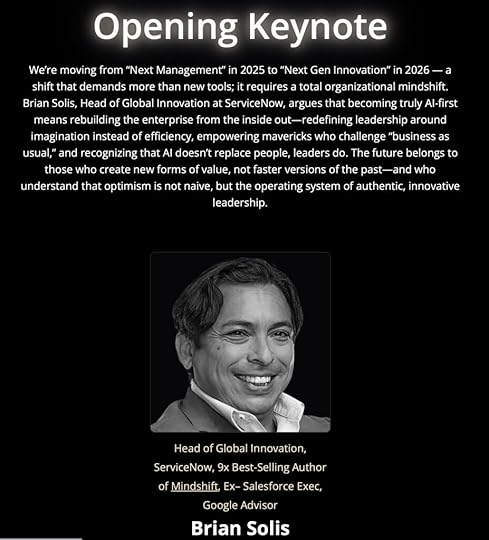
Screenshot
Screenshot
The post Brian Solis to Keynote AI Summit: Agentic Singularity appeared first on Brian Solis.
November 11, 2025
Brian Solis Named as a Top 50 Global Thought Leader in Sales by Thinkers 360
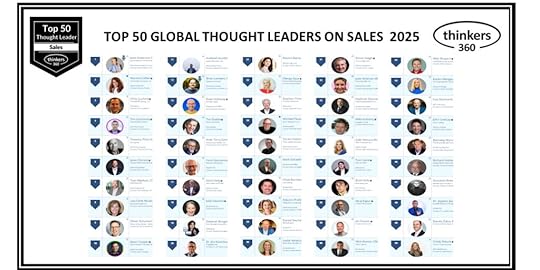
The Thinkers 360 listing includes members of Thinkers360 and who have curated and shared their thought leadership content from around the web – including articles, blogs, books, keynotes, media interviews, panels, podcasts, social media, speaking events, videos, webinars and whitepapers – via the platform to build their Thinkers360 profile, portfolio and media kit. Our differentiation from the various influencer leaderboards on social media, is that we take a holistic view of thought leaders, analysts and influencers, beyond their social media activity, and look across all the hats they may wear – such as academic, analyst, author, consultant, entrepreneur, influencer and speaker – and all the types of thought leadership content they produce.
AboutMore than just a list, Thinkers360TM live and annual leaderboards are differentiated by our unique patented algorithm that takes a holistic measure of thought leadership and authentic influence looking far beyond social media so brands can find exactly the right experts for their niche. Join us today! To find out more about how we calculate the rankings, please visit our article: Understanding the Thinkers360 Leaderboards.
The post appeared first on Brian Solis.
November 10, 2025
AI or Die: How 6% of AI High Performers are Rewiring Business Beyond the AI Status Quo
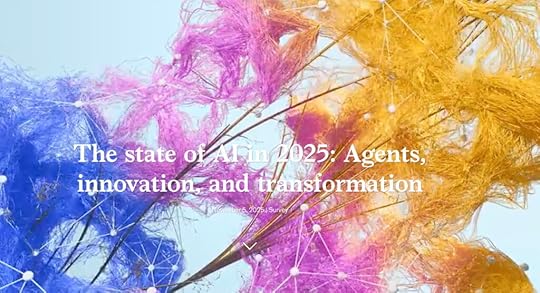
QuantumBlack AI by McKinsey released its new report, “The State of AI in 2025: Agents, Innovation, and Transformation.”
The data serves as a mirror, reflecting a world where AI is now everywhere, and yet, in most organizations, not nearly deep enough to transform them. Nearly all companies are “using AI,” many are flirting with agents, a tiny minority are breaking beyond the status quo, and an even smaller group is quietly exploring new horizons.
Below are the numbers that stood out to me.
Introduction: from experimentation to an AI divide
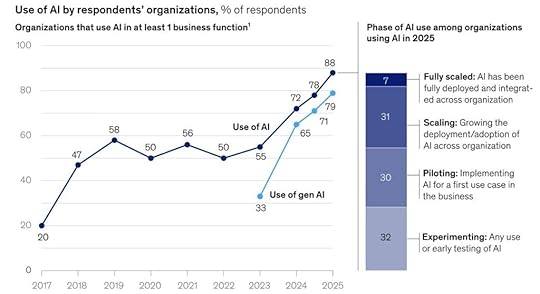
The headline is that 88% of companies now use AI in at least one function (up from 78%). But that was inevitable.
The story I’m paying attention to is the widening separation between:
organizations that treat AI as tools and pilots, andorganizations that treat AI as a new operating system for the business.McKinsey’s data confirms what many of us have been calling out in boardrooms: we’ve entered the agentic era, but most enterprises are still running legacy behaviors, patterns, and processes on next-generation technology. A small set of AI high performers (6%) are doing the opposite. They’re using AI, gen AI, and now agents to redesign workflows, re-architect value creation, and reimagine leadership itself. As result, they see EBIT impact of 5% or more.
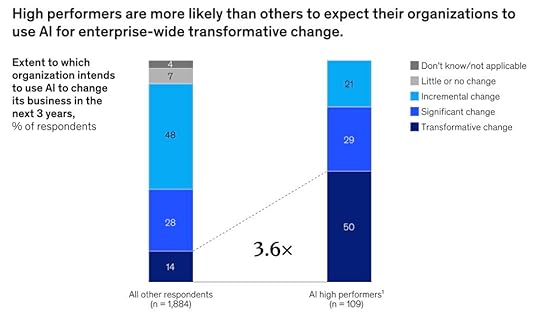
While the data tells a story of adoption, I’m looking at the companies writing a story about new identity and capacity.
What these stats are really saying (at a high level)…1. AI is now table stakes, but impact is optional88% using AI; 2/3 using it in multiple functions; ~1/2 in 3+ functions. This is ubiquity without guarantee of value. It tells us AI is no longer a differentiator by presence; it’s a differentiator by depth, design, and discipline.
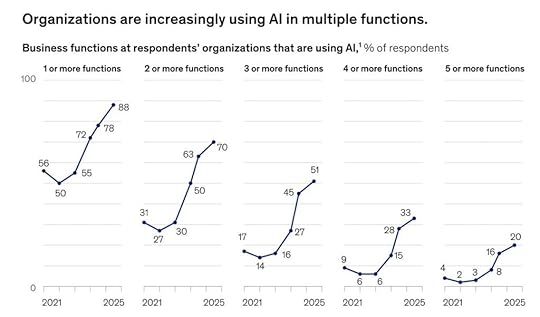
Yet only 39% tie any EBIT impact to AI, and most of that is <5%. Translation: most organizations have sprinkled AI on top of existing processes instead of rewiring how work gets done.
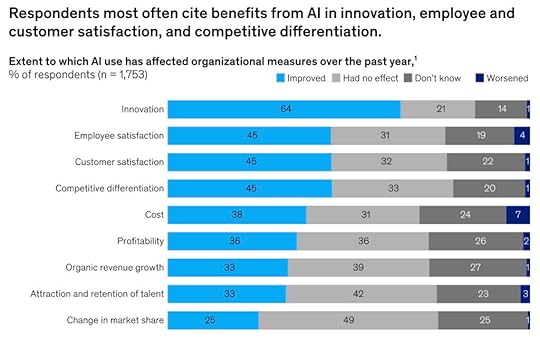
23% are scaling agentic AI in at least one function; another 39% are experimenting.
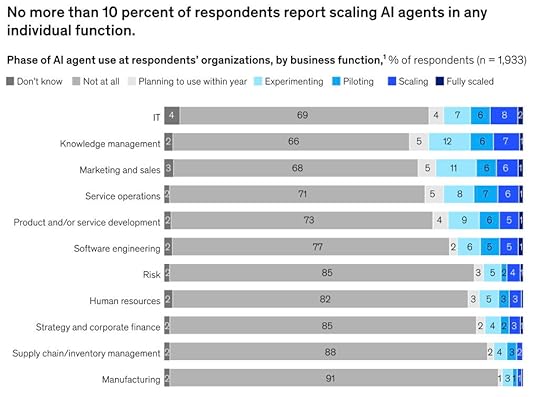
But in any function, only up to 10% say they are truly scaling agents, and usually in just 1–2 functions. Tech, media, telco, and healthcare lead.
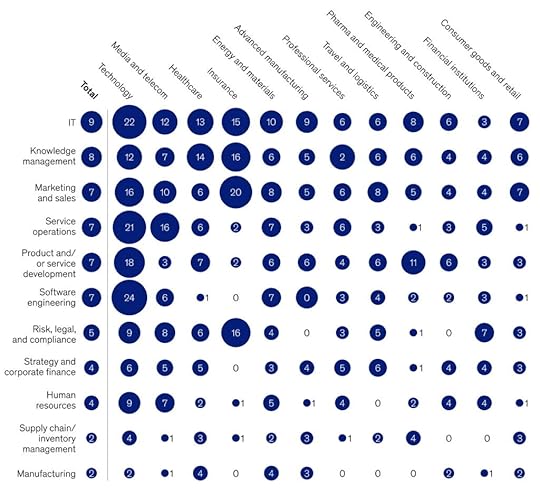
This signals a classic pattern: innovation at the edge, no unifying operating model. Agents are being deployed as bolt-on automation instead of end-to-end flow redesigns.
3. Scale is skewed to the big, and even they are earlyNearly half of companies with >$5B in revenue are in the “scaling” phase, versus 29% of those under $100M.
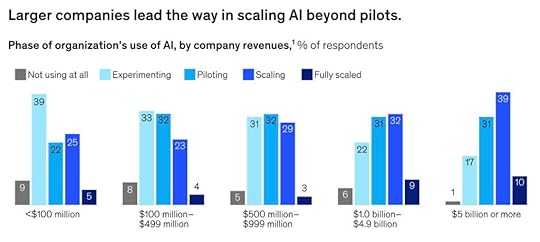
So far, scale favors the resourced. But that advantage is fragile. Smaller firms, if AI-native from the start, can move directly to agentic, automated, and adaptive models instead of dragging decades of technical and cultural debt.
4. The AI paradox: cost-out is easy; transformation is hardOrganizations are seeing point-level cost benefits, especially in software engineering, manufacturing, IT.
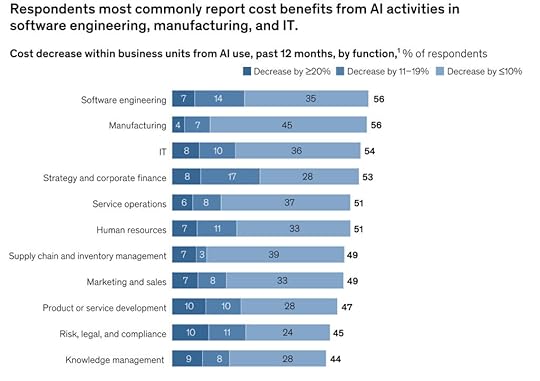
They report revenue and experience gains primarily in marketing & sales, strategy & corporate finance, and product development.
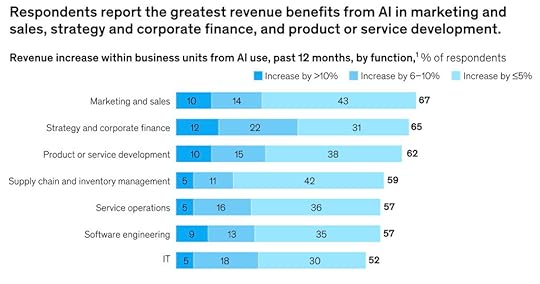
But enterprise-wide bottom-line change is “still rare.” That’s the paradox: lots of motion, little meaning. The companies stuck here think in terms of:
5. The 6%: what the AI high performers are actually doing“Where can we add AI?” Instead of: “Where can we reinvent value, experiences, and workflows with AI and agents at the core?”
That tiny cohort attributing 5%+ of EBIT to AI is the signal that matters.
Those “AI high performers” consistently:
Redesign workflows, not just tasks. These companies are ~3x more likely to say they’ve fundamentally rebuilt how work flows.

They deploy AI across more functions and are 3x more likely to scale agents across the business.
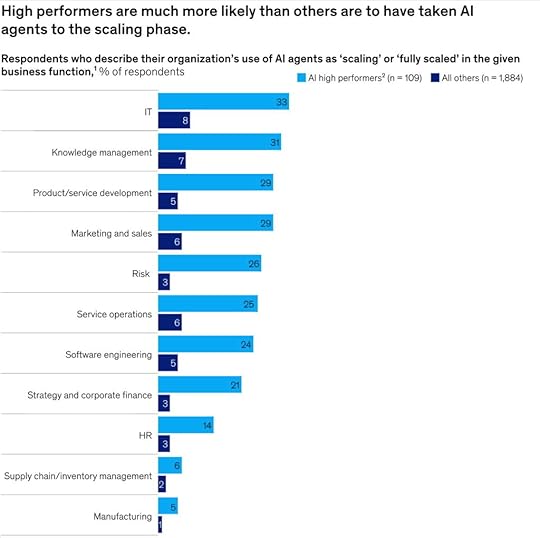
Treat leadership as the real platform: senior leaders sponsor, role model, and own AI initiatives. AI high performers’ use of AI is more often championed by their leaders. High performers are 3x more likely to strongly agree that senior leaders at their organizations demonstrate ownership of and commitment to their AI initiatives.
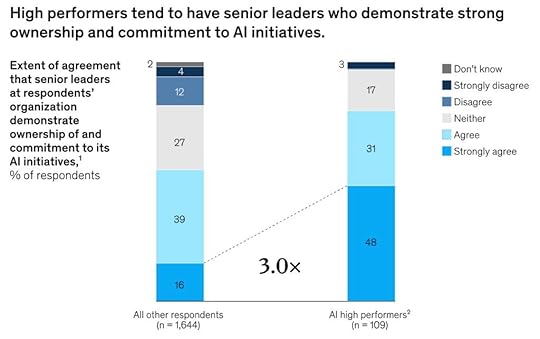
Run a full-stack playbook across 6 dimensions: 1) strategy, 2) talent, 3) operating model, 4) technology, 5) data, and 6) adoption and scaling. The most distinguished high performers employ a full set of management practices, based on more than 200 at-scale AI transformations.
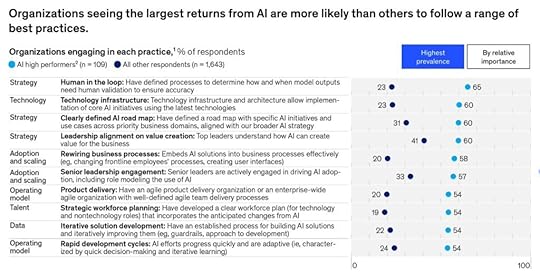
Invest like they mean it: 1/3 of high performers say they are investing >20% of digital budgets into AI; ~3/4 are scaling or have scaled.
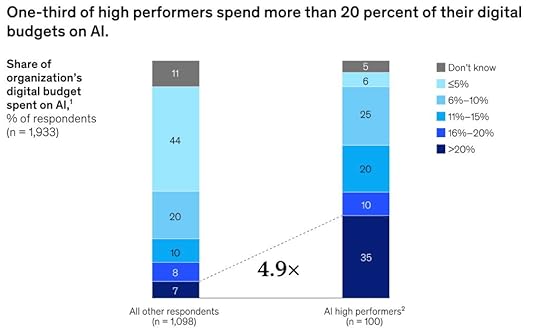
Simply said: they think bigger, move faster, and operate differently.
6. The mindset shift: beyond efficiency theaterOrganizations seeing the greatest impact from AI aim to achieve more than cost reductions. While most report that efficiency gains are an objective, high performers are more likely to also set growth and/or innovation as an objective of their AI efforts.
One of the clearest findings: Organizations that set growth + innovation (not just efficiency) as core AI objectives are more likely to see improvements in:
customer satisfactioncompetitive differentiationprofitability and revenue growtheven market share

This reinforces a central theme: efficiency is the floor, not the ceiling…meaning it’s not the bar for transformation. Treat AI only as a cost lever and you lock yourself into incrementalism while others build entirely new value chains.
From AI adoption to AI transformationIf you zoom out, this survey could also serve as a mirror that reflects outliers demonstrating curiosity, imagination, leadership, and courage.
Almost everyone has AI. Very few have the will to reimagine their company with it.
On one side we see “AI theater” where scattered pilots, siloed agents, slideware strategies, make no material impact.
On the other side, a small but growing set of agentic enterprises navigating new frontiers where they’re:
rewiring workflows,rebuilding their operating models,aligning culture, incentives, and leadership around a different future.
What if we dream bigger. Beyond asking, “How do we use AI to automate yesterday’s work and take out costs, we also ask, “If we started this company today, with AI, agents, and data at the core, how would we design it?”
That is the Mindshift.
This report should not reassure executives that they are “on track” because they have pilots in flight or agents in one function. It should unsettle them. It should make clear that the advantage is compounding in the hands of those 6% that are starting to break away from linear progression.
Assume that…
AI adoption is the next status quo.
Agentic AI is the next realm of exploration and possibility.
Re-architecting business, culture, and leadership becomes a force multiplier
This all sets the stage for cognitive Darwinism, companies that “think different” in how AI unlocks novel enterprise value.
AI or Die!
Read Mindshift | Book Brian as a Speaker | Subscribe
The post AI or Die: How 6% of AI High Performers are Rewiring Business Beyond the AI Status Quo appeared first on Brian Solis.
November 9, 2025
The Global Drucker Forum: Brian Solis on Mindshift, AI-Era Leadership, Value Creation, and the Power of Optimistic Innovation

Standing on the red carpet at the Global Peter Drucker Forum in Vienna with Franziska Graf, I was reminded why Peter Drucker’s ideas still matter…
In this short conversation at the historic Hofburg Palace, we explore:
1) The importance of a “Mindshift” right now, and how rethinking our mindset is the starting point for meaningful change.
2) How AI demands a next-generation model of leadership (hint: AI doesn’t decide who loses their job, leaders do).
3) Why the true role of the CEO, CIO, CHRO, and emerging Chief AI Officers is not to make tomorrow faster or cheaper or more scalable version of yesterday, but also to create new value that didn’t exist before.
4) Why optimism isn’t naive…a reminder that it’s a core pillar of innovation and authentic leadership.
Watch video on Youtube.
I’m grateful to Richard Straub, Julia Kirby, and the Drucker Forum community for creating a space where people genuinely committed to shaping the future of management (and leadership) come together to learn, challenge assumptions, and build what’s next.
And speaking of what’s next…we’re moving from “Next Management” in 2025 to “Next Gen Innovation” in 2026. The future of management depends on our ability to reimagine how we work, lead, and create value together.
| Keynote Speaker | Newsletter
The post The Global Drucker Forum: Brian Solis on Mindshift, AI-Era Leadership, Value Creation, and the Power of Optimistic Innovation appeared first on Brian Solis.

